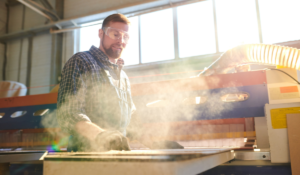Loss of life, property, injury, interrupted production, expensive litigation, negative publicity, and more – these are all the end results of combustible dust explosions. And, for many industries, combustible dust explosions are a very real threat, which require serious precautions to avoid.
Unfortunately, when these incidents occur all too frequently, it indicates a lack of sensitivity to the topic, or a lack of access to professional expertise in handling this hazard.
The fact is, a great percentage of powders handled in industry are recognized as flammable.
For instance, processing powdered sugar, flour, aluminum powder, and even aspirin can create significant risk of fire and explosion. This can occur when fine particulates of the substance become airborne, forming a potentially dangerous cloud.
Recently, in an effort to curb the dangers involved and crack down on those who put their team at risk, OSHA has made some changes to their Combustible Dust National Emphasis Program (NEP).
Now this brings us to the all-important questions: what is combustible dust, how can you avoid its dangers, and what changes has OSHA made?
Let’s take a look.
Related Article: New Application Makes Combustible Dust Detection Easy For Employers

What Is Combustible Dust?
Combustible dust is any powdery substance or particle that can easily become airborne and have combustible abilities.
These particles are smaller than 500 micrometers, or 0.005 millimeters, and can be composed of a variety of materials, such as:
- Metals; such as aluminum, magnesium, and titanium
- Plastics and other organic materials; such as wood flour and coal
- Inorganic materials; such as sulfur and phosphate
When suspended in the air, the dust can become combustible when an oxidant is present (such as oxygen), and there is also a source of ignition (like a spark, flame, or heat source). When this occurs, the dusts can combust, resulting in a fire or an explosive event.
And, it’s a deadly serious problem.
The U.S. Chemical Safety and Hazard Investigation Board (CSB) identified 281 combustible dust incidents between 1980 and 2005 that led to the deaths of 119 workers, injured 718, and extensively damaged numerous industrial facilities.
Related Article: OSHA Fines PA Recycler $88K for Combustible Dust Hazards
Here’s What’s New in the Combustible Dust National Emphasis Program
OSHA initiated the Combustible Dust NEP in October 2007, following a number of combustible dust incidents that resulted in numerous fatalities and serious injuries.
On January 27, 2023; OSHA announced a revised Combustible Dust National Emphasis Program.
According to the new update, the purpose of the revised emphasis program is to continue OSHA inspections of facilities that generate or handle combustible dusts which have a high likelihood to cause fire, flash fire, deflagration, and explosion hazards.
The updated Combustible Dust NEP which went into effect on January 30 replaces a March 2008 directive.
And, it will remain in effect until a cancellation notice is issued.
Of note, it does not replace another similar OSHA directive, referred to as the Grain Handling Facility Directive . However, it may cover operations involving grain processing which are outside the scope of the grain handling directive.
According to OSHA, wood and food products accounted for 70% of materials in combustible dust explosions and fires in 2018.
“Incident reports indicate that the majority of the industries involved in combustible dust hazards are wood processing, agricultural and food production, and lumber production, but others are susceptible as well,” the agency said in its January 27 press release.
OSHA has added the following industries to the NEP, by the North American Industry Classification System:
- 311812– Commercial bakeries
- 325910– Printing ink manufacturing
- 321912– Cut stock, re-sawing lumber and planing
- 316110– Leather and hide tanning and finishing
- 321214– Truss manufacturing
- 424510– Grain and field bean merchant wholesalers
Read more on OSHA’s official standards on combustible dust.
Prevent Combustible Dust Hazards with Good Housekeeping
A clean work environment remains essential for explosion prevention.
You can accomplish safe dust removal through good ventilation, extraction and removal systems, and dust collection systems. Additionally, manual cleaning procedures should be in place for any areas automated collection systems cannot reach.
In dusty environments, make sure you keep vacuums and other electrical equipment in good working condition, free of exposed wires, which can spark and cause ignition of airborne dust.
The best way to avoid dust accumulation is to be constantly aware of the surroundings.
Some general rules include, but are not limited to the following:
- Use appropriate electrical equipment and wiring methods;
- Use separator devices to remove foreign materials capable of igniting combustibles from process materials;
- Separate heated surfaces from dusts;
- Separate heating systems from dusts;
- Proper use, grounding, and type of industrial trucks and mobile equipment;
- Minimize the escape of dust from process equipment or ventilation systems;
- Locate relief valves away from dust hazard areas;
- Control static electricity, including bonding of equipment to ground;
- Control smoking, open flames, and sparks;
- Control mechanical sparks and friction;
- Never use compressed air, dry sweeping, or other cleaning methods that can disperse combustible dust into the air (when feasible);
- Limit and control potential ignition sources in dust accumulation areas;
- Pay attention to customer workforce training and education courses regarding recognition and control of combustible dust hazards, and follow the instructions given at the training sessions;
- Maintain an effective housekeeping program to prevent or eliminate dust buildup on ledges, ductwork, building framing, or other surfaces. Even small accumulations of dust [as little as 1/32 of an inch] can create a dust explosion hazard if spread over sufficient surface area.
Bringing It Together
It’s important to take the necessary safety measures to avoid combustible dust accumulations, fires, and explosions.
Depending on the source, location, and environment, combustible dust may need to be removed on a regular basis. Good housekeeping practices should be followed, such as sweeping and vacuuming up dust.
Additionally, workers should avoid smoking or bringing any other ignition sources into areas where combustible dust is present.
Finally, ensure proper ventilation remains in place to minimize the accumulation of dust and potential ignition sources at the worksite.
Dust creation remains an unavoidable part of numerous industries. However, the explosive dangers they present are not.
***
About Worksite Medical
In most cases, OSHA requires medical surveillance testing, and at no cost to employees.
Worksite Medical makes that program easier with mobile medical testing.
We conduct on-site respirator fit tests, as well as audiometric exams, pulmonary function tests and heavy metal lab work, right on your job site. We also keep accurate, easy-to-access medical records for your convenience. You’ll keep your employees at work, and stay ahead of OSHA inspections.




